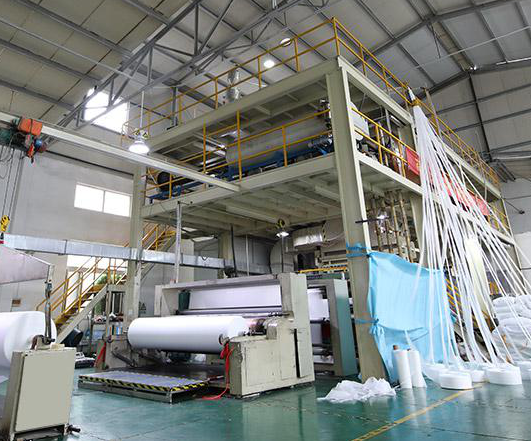The production process of spunlace non-woven fabrics.
Most people are not very familiar with spunlace non-woven fabrics, but for many friends who are engaged in fabric processing and production, they are familiar with
Spunbonded nonwovens. Now most of the fabrics are densely intertwined with dense fibers. The spunlace non-woven fabric is no exception, but it is composed of multiple layers of fibers, and it contains a wide range of fibers, and its fiber raw materials are diverse. The following will introduce the production process of spunlace non-woven fabrics.
1. Spunlace non-woven process:
A. Fiber raw materials→opening and blending→carding→cross*laying→drafting→→pre-wetting→positive and negative spunlace→finishing→drying→winding↑ ↑water treatment cycle
B. Fiber raw materials→opening and blending→carding messy web formation→→pre-wetting→positive and negative spunlace→post-finishing→drying→winding↑ ↑Different web forming methods of water treatment cycle affect the vertical and horizontal strength ratio of the final product. A has better adjustment of the strength ratio of the fiber web in the vertical and horizontal directions, which is suitable for the production of spunlace synthetic leather base fabric; Process B is suitable for the production of spunlace sanitary materials.
二、Pre-wet
The formed web is sent to the spunlace machine for reinforcement, first of all it is pre-humidified.
The purpose of pre-wetting is to compact the fluffy web and remove the air in the web, so that the web can effectively absorb the energy of the water jet after entering the spunlace area to enhance the fiber entanglement effect.
Common pre-wetting methods:
<> Double net clamp type
<> Perforated roller and net curtain clamp type
Three, spunlace
The pre-wet fiber web enters the spunlace area, and the spray hole of the spunlace head sprays out multiple fine water jets, which are directed towards the fiber web. The water jet displaces part of the surface fibers in the fiber web, including vertical movement to the opposite side of the fiber web. When the water jet penetrates the fiber web, it is rebounded by the net curtain or the rotating drum and scattered to the fiber web in different directions. The opposite. Under the dual effects of the direct impact of the water jet and the rebound water flow, the fibers in the fiber web are displaced, interleaved, entangled, and entangled, forming countless flexible entanglement points, thereby strengthening the fiber web.
The vertical jet of water jet on the web can prevent damage to the web structure, and utilize the energy of the water jet to the greatest extent, thereby helping to improve the performance of the spunlace nonwoven material.
Spunlace reinforcement methods mainly include flat net spunlace reinforcement, rotating drum spunlace reinforcement, and a combination of rotating drum and flat net spunlace reinforcement.
Supporting net curtain weaving structure and fiber web appearance structure effect In the spinning drum spunlace reinforcement process, the spunlace heads are arranged along the circumference of the rotating drum, and the fiber web is adsorbed on the rotating drum and is sprayed by the water jet from the spunlace head. The fiber web is adsorbed on the drum, and there is no deviation phenomenon, which is conducive to high-speed production. At the same time, the fiber web moves in a curved surface in the spunlace area, and the spunlace surface is relaxed and the reverse surface is compressed. Tangled fibers.
The rotating drum is a metal cylinder with a perforated structure with a dewatering device inside. Compared with the flat net spunlace reinforced net curtain, it has a good rebound effect on water flow.
(3) Spunlace reinforcement by the combination of rotating drum and flat net. In the spunlace reinforcement process, the combination of flat and rotating drums can maximize strengths and avoid weaknesses, and give play to their respective advantages. Usually, the first and second stages are drum water Spunlace, the third level is flat-net spunlace.
(4) The number of spunlace heads and the number of spunlace heads commonly used in the hydraulic spunlace reinforcement process is 7~12, and the common water pressure is 60~250Bar, depending on the unit area quality of the fiber web and the production speed. The pressure setting is usually low→high→low.
(5) Structural analysis of water jets According to fluid mechanics, water jets from water jets can be called non-submerged free turbulent jets. After the water jet is ejected from the spray hole, due to the lateral pulsation of the turbulent jet and the frictional resistance of the air convection, it gradually transforms from the clustered jet to the scattered water droplets.
Four, dehydration
The purpose of dehydration is to remove the retained water in the fiber web in time, so as not to affect the tangling effect during the spunlace. When the amount of water retained in the fiber web is large, it will cause the dispersion of the water jet energy, which is not conducive to fiber entanglement. After the spunlace process is completed, the moisture in the fiber web is reduced to a minimum, which is beneficial to reduce drying energy consumption.
5. Water treatment and recycling
Spunlace nonwovens production process requires a lot of water. When the output reaches 5 tons/day, water consumption is about 150m3~160m3 per hour. In order to save water and reduce production costs, about 95% of the water must be recycled after water treatment.













